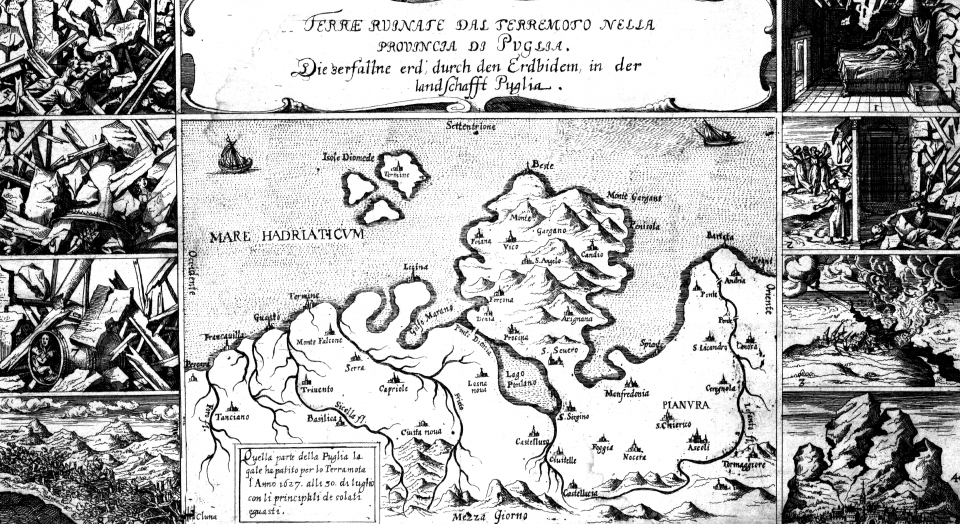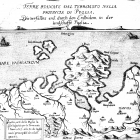
Broadsheet from woodcut: “Ruined Earth,” 1627. (Uknown artist. All rights reserved. Courtesy of the Bavarian State Library.)
Broadsheet from woodcut: “Ruined Earth,” 1627. (Uknown artist. All rights reserved. Courtesy of the Bavarian State Library.)
Broadsheet from woodcut: “Ruined Earth,” 1627
Featured on the Environment & Society Portal with kind permission of the Bavarian State Library. Broadside catalogue, call number: Einbl. V,8 ir.
The copyright holder reserves, or holds for their own use, all the rights provided by copyright law, such as distribution, performance, and creation of derivative works.
The caption of this broadsheet is written in Latin and German: it is part of a script by Giovanni V. de Poardi “Relatio historica terrae motus horribilis … Rom 1627” [Historical Context of the Terrible Earthquake …Rome 1627]. The book Historical Seismology (page 232) states that this earthquake played a key role in the development of earthquake science. After the earthquake, the Italian Matteo Greuter created the first map that represented the intensity of earthquake damage. On July 30, 1627
a terrible earthquake occurred. A loud crash preceded the main shock… . In the city of S. Severo, where all buildings including palaces and banks were destroyed completely and about 800 people were killed, the settlements in its vicinity suffered most seriously (Serracapriola was almost completely destroyed, 2,500 people were killed; S. Paolo di Civitate suffered the same fate, 350 people were killed; a great part of the Ripalta abbey was destroyed; all buildings in Apricena were destroyed, 900 inhabitants were killed; Sannicandro became a heap of ruins; many houses in Chieti collapsed; and so on)… . The earthquake was felt in Naples and Dubrovnik. The total number of victims was 5,000. Continuous aftershocks accompanied by a rumble were felt during five hours after the earthquake… . The tsunami embraced a vast part of the shore. It was reported with some exaggeration that the coastal town of Termoli ‘collapsed’ into the sea. (47–48)
—Sergey L. Soloviev, ed., Tsunamis in the Mediterranean Sea, 2000 BC–2000 AD
Call number: Einbl. V,8 ir and Cgm 6116 Notes from the BSB catalogue: A German version of the broadsheet, basically identical with the German text of the broadsheet (only the first paragraph of the Latin text can also be found in the broadsheet) was published in 1627 under the name “Relation, von dem grossen schröcklichen Erdbidem/ der sich im Königreich Napleß…Jetzt verteutscht. Augsburg: Aperger, Andreas 1627” [Relation of the Big, Terrible Earthquake in the Kingdom of Naples…Now Translated into German. Augsburg: Aperger, Andreas 1627].
- Patacca, E. and P. Scandone. 'The 1627 Gargano Earthquake (Southern Italy): Identification and Characterization of the Causative Fault.' Journal of Seismology 8, no. 2 (2004): 259–73.


